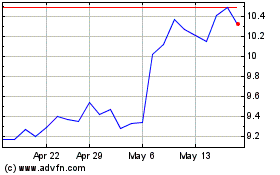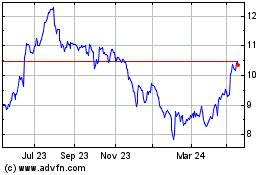AGL Under Pressure to Keep Coal-Fired Plant Running Longer
September 12 2017 - 12:58AM
Dow Jones News
By Robb M. Stewart
MELBOURNE, Australia--Plans by one of Australia's largest
utilities to phase out coal-fired power stations is running up
against a government supportive of the fuel and eager to counter
the threat of blackouts by extending the life of the company's
oldest plant.
Under pressure from Canberra to run its Liddell plant in the
coal-rich eastern Hunter Valley for five years beyond the slated
2022 closing date or sell it to another operator, AGL Energy Ltd.
(AGL.AU) Chief Executive Andy Vesey said he had agreed to take the
government's request to his board.
He also committed to delivering to the government in 90 days
alternative action the company would take to avoid a power
shortfall when Liddell reaches the end of its scheduled life. Prime
Minister Malcolm Turnbull said that while all options would be
considered by the government, the most obvious one was to keep the
station running for longer.
"AGL's management want to look after their shareholders. For
them, scarcity of energy is good because it enables them to raise
prices. It's not good for the Australian people," Mr. Turnbull said
Tuesday.
Tension between the company and the Turnbull government
highlights the contrast between Australia's vast resources of both
coal and natural gas and looming threats of shortages and jumps in
prices for businesses and households. Earlier in the year, the
government introduced new powers to curb exports of liquefied
natural gas from big plants on the east coast if it finds there's a
threat of a gas-supply shortage in local markets, even as the
country is set within a few years to overtake Qatar as the world's
biggest LNG exporter.
The Australian Energy Market Operator, which runs much of the
country's gas and electricity markets, earlier this month warned of
a tight electricity market in the southeast following the recent
closure of Engie SA's (ENGI.FR) coal-fired Hazelwood plant. It
projected the need for 1 gigawatt in baseload capacity for populous
New South Wales and Victoria states to replace Liddell.
Coal accounts for more than 60% of the country's electricity
production, down from more than 80% at the beginning of the
century, according to government data.
The decline in coal use comes amid strong growth in wind and
solar projects. Sustainable Energy Research Analytics, a
consultancy, estimated there are about 311 megawatts of solar power
now in operation in Australia, 1 gigawatt under construction and a
further 6 gigawatts in advanced stages of design. However, without
massive storage, renewable energy doesn't meet the government's
call for more on-demand baseload electricity.
Mr. Turnbull, who has long promoted the construction of new,
cleaner-burning coal plants, recently laid out plans for an
expansion of the Snowy Mountains hydro-electricity project, which
would add 2 gigawatts of power to the market, but not until after
Liddell is set to close.
AGL has committed to closing each of its coal-fired plants when
they reach the end of the operating life, a process set to run
through 2050, replacing the capacity through gas-fired plants,
pumped hydro and batteries, in addition to wind and solar
generation.
Mr. Vesey said that in the near term, new development favored
renewables supported by gas, a trend expected to continue over the
longer term as large-scale battery systems support renewable
technology. "In this environment, we just don't see new development
of coal as economically rational, even before factoring in a carbon
cost," he said.
Liddell's four generation units were commissioned between 1971
and 1973, supplying enough electricity a year to power more than 1
million homes. But as they age unplanned outages are expected, Mr.
Vesey said.
Since buying the plant in 2015, AGL said it had invested 123
million Australian dollars (US$98.8 million) and it intends to
spend a further A$159 million before it closes, yet Liddell still
contributed to blackouts in New South Wales earlier this year when
two units went down due to boiler leaks.
Delta Electricity, which owns the Vales Point coal station in
New South Wales, said it would consider buying Liddell but that it
would need to know the condition of the plant and the cost of
maintaining operations. Any buyer would also be faced with
rehabilitation costs when the plant does close, a figure AGL has
estimated at A$898 million for the Liddell and neighboring
Bayswater coal-powered station.
Write to Robb M. Stewart at robb.stewart@wsj.com
(END) Dow Jones Newswires
September 12, 2017 00:43 ET (04:43 GMT)
Copyright (c) 2017 Dow Jones & Company, Inc.
AGL Energy (ASX:AGL)
Historical Stock Chart
From Dec 2024 to Jan 2025

AGL Energy (ASX:AGL)
Historical Stock Chart
From Jan 2024 to Jan 2025
